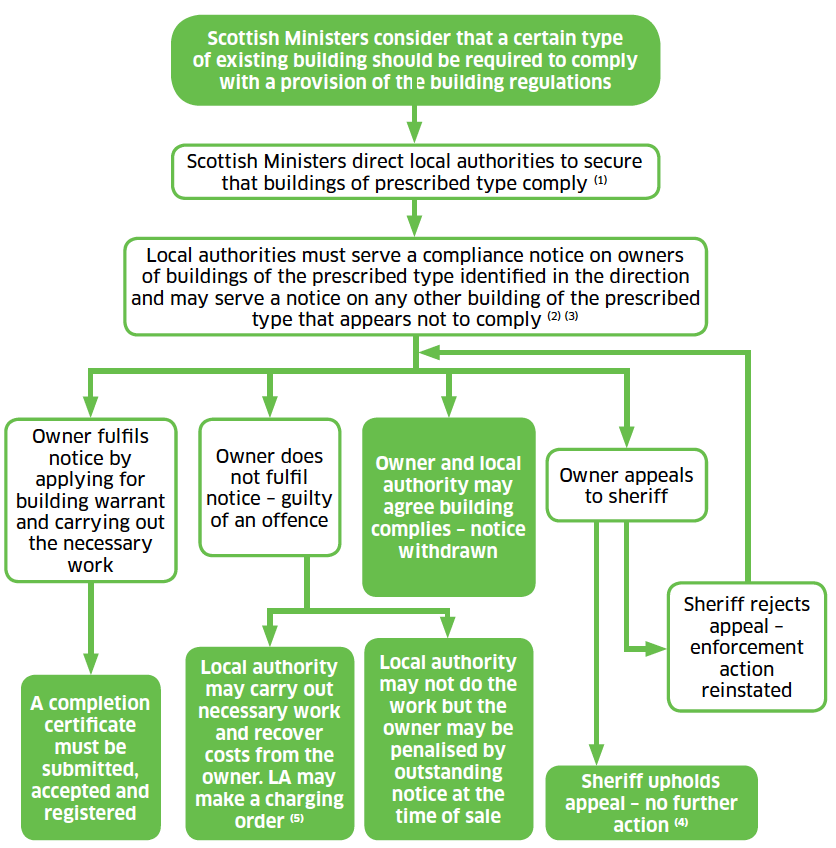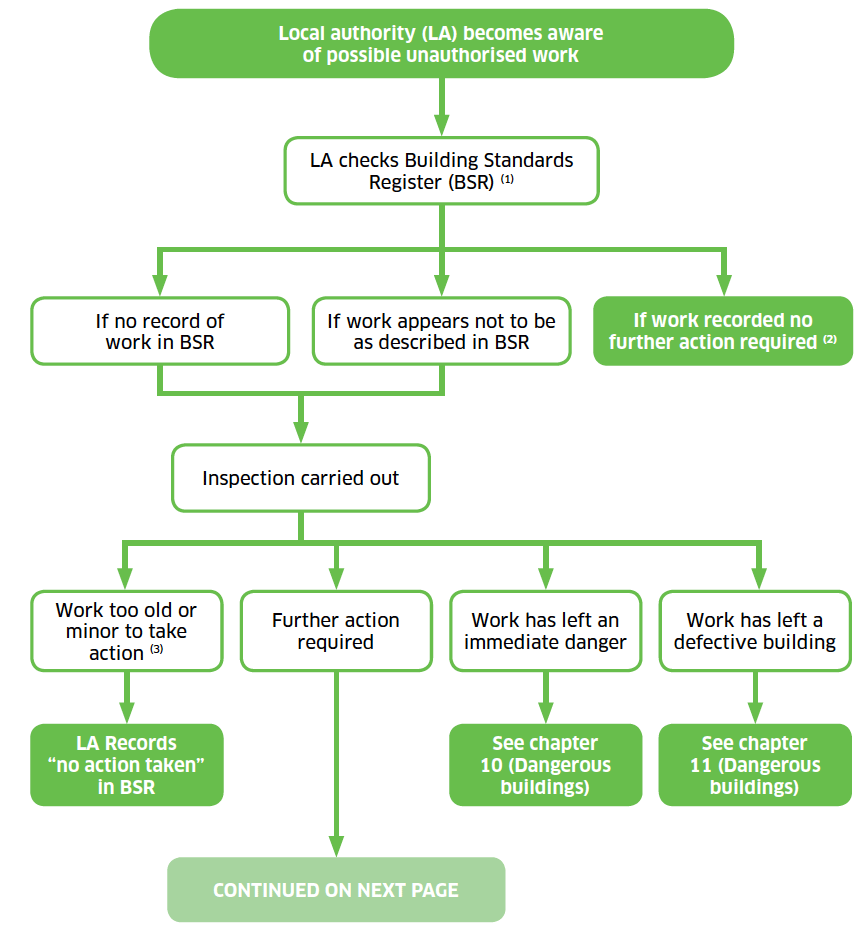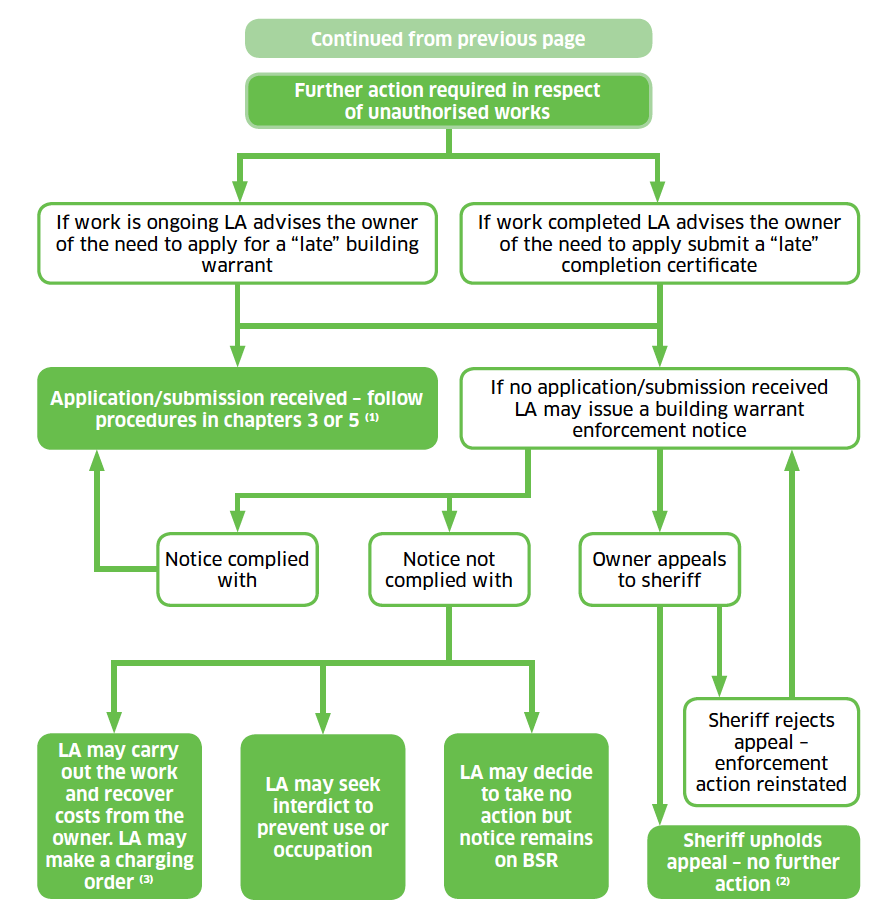Building standards: procedural handbook (third edition, version 1.6)
Clarifies procedures underpinning the Scottish building standards system as set out in the Building (Procedure) (Scotland) Regulations 2004 and the Building (Scotland) Act 2003 to help with practical operation.
This document is part of a collection
7 Compliance and enforcement
7.1 Building regulations compliance notices
7.1.1. Where Scottish Ministers consider it essential that certain types of existing building should be required to comply with the current standards, they may direct local authorities to take action to ensure that these buildings are made to comply. The local authorities must serve on the owners of identified buildings of the prescribed type a ‘building regulations compliance notice’ (see section 25 of Act). The local authorities may also serve a notice where it appears any other building of the prescribed type does not comply and this provision of the Act will apply if the initial identification was of specific buildings. This power is limited to the purposes specified in the Act for the building regulations and can be applied only to buildings of a type to which the building regulations apply.
7.1.2. The notice must specify the provision of the regulations to be met (usually specified by reference to a functional standard), a date (not less than 28 days after the notice takes effect) after which the building must comply, any particular steps that must be taken and the date of effect.
7.1.3. The issue of a building regulations compliance notice does not preclude the need to obtain building warrant approval if a warrant is required for the work. However, if the owner has applied for a warrant (and notified the local authority if in future the local authority is not the verifier) by the specified completion date, the local authority may alter the date by which the building must comply.
7.1.4. If, by the final specified completion date, the owner has not complied with the notice, the owner is guilty of an offence. The local authority may then carry out the necessary work to make the work comply with the specified provision and can recover the costs from the owner. A local authority entitled to recover its costs may make a charging order in favour of itself and register it in the appropriate land register (see 10.8). A local authority does not need a warrant to do work carried out so as to enforce a notice but after completion the authority must register in the building standards register, a completion certificate.
7.1.5. A local authority may withdraw a notice or waive or relax any requirement of a notice or substitute a later date for completion, whenever it sees fit. Such a withdrawal does not, however, preclude the issue of a further notice.
Figure 7: Compliance
Process Applying To Building Regulation Compliance Notices

Note
1. The BSD carries out this process on behalf of Scottish Ministers.
2. Notices must be recorded on the Building Standards Register.
3. The local authority may withdraw a notice or waive or relax any requirement of a notice, or submit a later date for completion whenever it sees fit.
4. The particulars of the notice should be removed from the Building Standards Register.
5. A local authority entitled to recover its costs may make a charging order in favour of itself and register it in the appropriate land register (see 10.8).
7.2 Building warrant enforcement notices
7.2.1. In the following cases, where local authorities consider it necessary, a ‘building warrant enforcement notice’ may be served on the relevant person (see 7.2.3). The three cases are:
- that work requiring a warrant has been or is being done without a warrant;
- that work has been or is being done that is not in accordance with a warrant that has been granted; or
- that a limited life building has not been demolished by the expiry of the period for which a warrant has been granted.
Note that work listed in schedule 3 of the building regulations as work not requiring a warrant may have a notice served if the work does not comply with any relevant requirement of the building regulations. This is because such work is only exempt if it does comply.
7.2.2. A building warrant enforcement notice may be required:
- for ongoing work without a warrant, that a building warrant be obtained;
- for completed work without a warrant, that a completion certificate be submitted and the verifiers acceptance obtained;
- for work not carried out in accordance with the warrant, that the work be altered to comply or that an amendment of warrant covering the changes be obtained; or
- for a limited-life building that has not been demolished, that a warrant for the demolition be obtained and the building demolished.
Note that in the case where a completion certificate is required to be submitted, it will be a late submission treated like a warrant application and, unlike a normal building warrant application, there will be time to negotiate changes on site to comply if necessary before acceptance is given.
Note also that Section 27(5) of the Act allows the local authority to suspend the work until the terms of the notice are met. The notice may also specify particular steps that must be taken to comply and that may include the removal of works that are unlikely to comply even after alteration.
7.2.3. The relevant person for the demolition of a limited-life building is the owner. For the other cases the relevant person will be either:
- the owner, tenant or developer doing the work or conversion themselves; or
- the owner, tenant or developer who has employed a builder to do the work for them.
In cases where the above relevant person cannot be found, or no longer has an interest in the building, the notice is served on the current owner.
7.2.4. The notice will specify a date by which these actions must be completed, although it will never be less than 28 days after the notice takes effect. The date of effect must also be specified on the notice. Copies of notices must be sent to the owner and/or occupier of a building if they are not the person receiving the notice. A copy should also be served on any other person with an interest as determined by the local authority.
7.2.5. In some cases, the local authority will specify particular steps that must be taken in complying with the notice. Where work that needs a warrant is being carried out without a warrant or not in accordance with a warrant, the local authority may specify on the notice that work is suspended (other than work for complying with the notice). To comply with the notice a warrant must be obtained, not just applied for, before works may start again.
7.2.6. If, before the completion date specified in the notice, the person on whom it is served applies for a relaxation and informs the local authority of the application, the completion date must be re-specified by the local authority. This date will now be not less than 28 days after the date of the decision on the application for a relaxation.
Note, however, that an appeal does not invalidate a stop notice unless the Sheriff chooses to quash it.
7.2.7. If, by the final specified completion date, the relevant person has not met the requirements of the notice, that person is guilty of an offence. The local authority may then carry out the necessary work to make the work comply and can recover the costs from the person. A local authority entitled to recover its costs may make a charging order in favour of itself and register it in the appropriate land register (see 10.8). Compliance is with the building regulations when the work is done without a warrant and with the notice when the work is done not in accordance with a warrant. This can also apply to cases where a limited life building has not been demolished when specified. A local authority does not need a warrant to do work carried out to enforce a notice but after completion must register a completion certificate.
7.2.8. A local authority may withdraw a notice or waive or relax any requirement of a notice or substitute a later date for completion whenever it sees fit. Such a withdrawal does not, however, preclude the issue of a further notice.
7.2.9. Although verifiers must accept a certificate of design as conclusive of the facts to which it relates when determining the application for warrant, this does not prevent verifiers, when checking work on site, from reporting failures to build in accordance with the warrant. A local authority could then serve a building warrant enforcement notice.
7.2.10. An approved certifier of construction should note that, should they certify work that is not in accordance with the warrant, without an amendment to the warrant being sought, they are committing an offence and placing their client at risk of enforcement action. A certifier should not certify:
- work that is ongoing; or
- work that has been completed by another party without sufficient checks, inspection or tests to ensure compliance with the warrant as finally amended and with building regulations.
7.3 Continuing requirements imposed by verifiers
7.3.1. Under section 22 of the Act, when granting a warrant or accepting a completion certificate, a verifier may impose a continuing requirement. Such a requirement imposes on a building owner a duty that the verifier feels must be fulfilled after the completion of the building to ensure the purposes of the building regulations are not frustrated.
7.3.2.This is not intended to cover matters that always rely on adequate maintenance, such as the operation of lifts or the recoating of woodwork. Nor is it for matters under health and safety or fire precautions legislation, such as testing of alarms. In general, it is also not for matters that involve action on the part of the owner. It is for special cases where the arrangements agreed for complying with the functional standards might be frustrated by uncontrolled changes. A typical example would be acceptance of a moveable platform for cleaning windows subject to a continuing requirement that adequate access and hard surfaces are provided and then kept clear and properly surfaced thereafter.
7.3.3. Such continuing requirements, therefore, relate to activities or actions happening to a building element, not the building element in itself.
7.4 Continuing requirements imposed by Ministers
7.4.1. Section 2 of the Act allows Scottish Ministers to impose continuing requirements on building owners in a different way. Here Ministers can include in the regulations certain matters that apply after the warrant and completion certificate process is complete. Further, the requirements may be imposed on existing buildings, whenever built.
7.4.2. The intent of this regulation is to allow Scottish Ministers to impose continuing requirements nationally. For example, it could be used for assisting with the implementation of certain terms of European Directives.
7.4.3. This form of continuing requirement can only relate to a provision of the regulations which is designated in the Building (Scotland) Regulations 2004 (as amended) as one to which such requirements may apply. At present, only Regulation 17, which covers the maintenance of certain air conditioning system, is so designated.
7.5 Continuing requirement enforcement notice
7.5.1. The local authority for the geographical area in which a project or building is located is responsible for the enforcement of the regulations. This applies irrespective of whoever carried out the verification role. In particular, the local authority has responsibility for enforcing continuing requirements, whether imposed by verifiers or by Scottish Ministers, where building owners have failed in their duty.
7.5.2. The local authority may serve a notice on the owner of a building requiring compliance (see section 26 of the Act for details). Where compliance is not achieved, the owner has committed an offence and the local authority can carry out any necessary works, register a completion certificate and recover costs from the owner. A local authority entitled to recover it’s costs may make a charging order in favour of itself and register it in the appropriate land register (see 10.8).
7.6 Other offences and enforcement
7.6.1. The notices described in 7.5 are designed to ensure work is done in accordance with the building warrant. There are other enforcement possibilities, relating to the other offences set out in the Act.
7.6.2. In relation to certificates of design, a verifier must accept certificates forming part of an application for warrant as conclusive of the facts to which they relate. If all other matters comply, a warrant must be granted. However, if a verifier considers that a certifier may have committed an offence under section 11(4) of the Act by issuing a false or misleading certificate, the verifier should report the matter to the procurator fiscal service.
7.6.3. Similarly, in relation to certificates of construction, a verifier must accept certificates forming part of a submitted completion certificate as conclusive of the facts to which they relate. If all other matters comply, a completion certificate must be accepted. However, if, after accepting a certificate, a verifier becomes aware that a certifier may have committed an offence under section 19(4) of the Act by issuing a false or misleading certificate, the verifier should report the matter to the procurator fiscal service.
7.6.4. Whenever an approved certifier is reported to the The Crown Office and Procurator Fiscal Service (COPFS), the BSD should also be informed and the relevant Scheme Provider organisation.
7.6.5. If a building is occupied without a completion certificate having been accepted or without permission for temporary occupation having been granted (see section 21 of the Act) the Court may restrain or prevent the occupation or use.
7.6.6. For enforcement related to dangerous or defective buildings, see chapters 10 and 11 respectively.
Figure 8: Unauthorised work
Procedures Applying To Unauthorised Work

Note
1. LAs would also check register of applications under the 1959 Act for works prior to 1/5/05.
2. Provided the record confirms that work is properly completed.
3. The local authority may offer a ‘letter of comfort’ scheme for old or minor works. These schemes, where operated, are particularly relevant to the conveyancing process.
Figure 9: Unauthorised work - continued

Procedures Applying To Unauthorised Work
Note
1. Although it is possible to apply for a building warrant after work has commenced or submit a completion certificate without a warrant, an offence will have been committed in both cases.
2. The particulars of the notice should be removed from the Building Standards Register.
3. A local authority entitled to recover its cost may make a charging order in favour of itself and register it in the appropriate land register (see 10.8).
7.7 Consultation and limitations for scheduled monuments, listed buildings etc.
7.7.1. For the purposes of enforcement under the Act, the following are designated as scheduled monuments, listed buildings etc.:
- scheduled ancient monuments;
- listed buildings;
- buildings subject to preservation orders; and
- those buildings in conservation areas subject to control of demolition.
Ancient monuments are those included in the schedule of monuments compiled and maintained under section 1 of the Ancient Monuments and Archaeological Areas Act 1979.
Listed buildings are those included in a list of buildings of special architectural or historic interest compiled or approved under section 1 of the Planning (Listed Buildings and Conservation Areas) (Scotland) Act 1997, preservation orders are under section 3 of that Act and control of demolition is under section 66 of that Act.
7.7.2. Before serving notices on historic buildings as defined in the Act there must be consultation with Scottish Ministers (through Historic Environment Scotland), the planning authority (where this is not the local authority) and anyone else the local authority consider necessary. Where the planning authority is within the same authority there should still be a properly recorded consultation.
7.7.3. The only qualification of this requirement is that, in relation to a dangerous building notice or urgent work needed to remove a danger, consultation is required ‘if reasonably practicable’. This is intended to cover problems requiring immediate action; in these instances the relevant authorities should be notified subsequently of any such action.
7.7.4. There is also an important limitation on the notices. Except in an urgent case as described above, the effect of the notices on a person required to do work in relation to any of the enforcement notices is restricted to work that is not inconsistent with any provisions of the legislation designating the historic buildings.
Contact
Email: buildingstandards@gov.scot
There is a problem
Thanks for your feedback